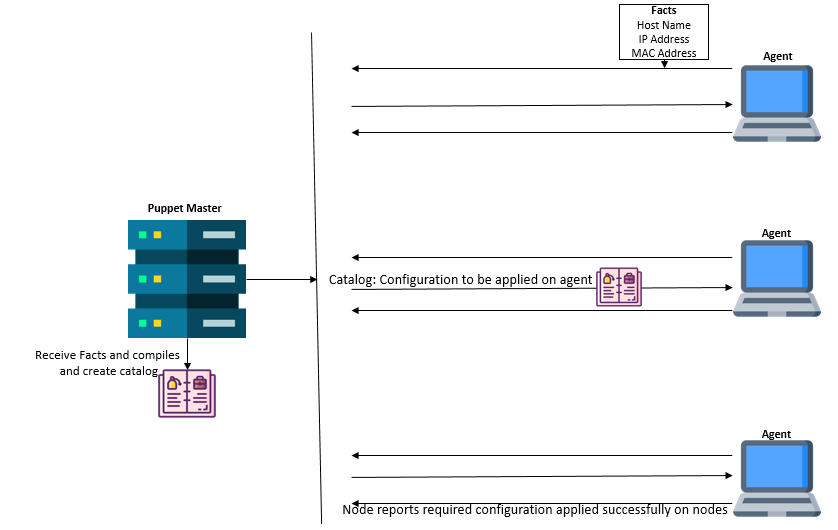Will see Installing Puppet in RHEL7/ Cent OS 7
Nowadays all the administration tasks are rapidly moving to automation and its reducing manpower, cost and time. It’s mandatory to learn any one of the scripting and anyone of automation tool for system administrators at this situation. Automating tasks in server end is very critical and most important one. There are lots of tools available for automation. Here we are going to see the puppet.
What is puppet?
It’s an open source tool and developed by puppet labs for Linux/Unix/Mac and Windows machines. Puppet is written in Ruby language and its mostly used for automating jobs in the server and automating the jobs from the server to clients.
Features:
To avoid duplication of work.
Powerful framework
Mature tool
System administrator tasks simplify.
To make speed and repeated changes automatically.
To maintain system consistency and integrity
Very easy to manage vm, cloud and physical machines.
Enabling EPEL repository and dependencies for installation:
System time should be set as accurately on server, which is going to act as master chef server. So, set the time in your server.
Make sure that both the master and agent server should resolev the hostnames. So, make an entry in /etc/hosts file.
once time fixed will enable EPEL repository by using below command.
RHEL7/ Cent OS 7:
[root@server init.d]# rpm -Uvh https://dl.fedoraproject.org/pub/epel/epel-releas e-latest-7.noarch.rpm
Retrieving https://dl.fedoraproject.org/pub/epel/epel-release-latest-7.noarch.rpm
warning: /var/tmp/rpm-tmp.yXngEr: Header V3 RSA/SHA256 Signature, key ID 352c64e 5: NOKEY
Preparing... ################################# [100%]
Updating / installing...
1:epel-release-7-10 ################################# [100%]
List the EPEL Repository Packages :
[root@server init.d]# yum --disablerepo=* --enablerepo=epel list
Now to have puppet ready setup, have to use apache with passanger. To get that, download and place the repo file in /etc/yum.repos.d/
[root@server init.d]# curl --fail -sSLo /etc/yum.repos.d/passenger.repo https://oss-binaries.phusionpassenger.com/yum/definitions/el-passenger.repo
To setup puppet master/node now we need to enable the puppet lab repository and dependencies and run it on both master and agent servers.
[root@server init.d]# rpm -ivh https://yum.puppetlabs.com/puppetlabs-release-el-7.noarch.rpm
Retrieving https://yum.puppetlabs.com/puppetlabs-release-el-7.noarch.rpm
Preparing... ################################# [100%]
package puppetlabs-release-22.0-2.noarch is already installed
Installing Puppet:
Use the below command to install Puppet server. This will install init script (/etc/init.d/puppetmaster) to run a test-quality puppet master server.
[root@server ~]# yum install puppet-server
Installed:
puppet-server.noarch 0:3.8.7-1.el7
Dependency Installed:
facter.x86_64 1:2.4.6-1.el7 hiera.noarch 0:1.3.4-1.el7 libselinux-ruby.x86_64 0:2.5-6.el7 libyaml.x86_64 0:0.1.4-11.el7_0
puppet.noarch 0:3.8.7-1.el7 ruby.x86_64 0:2.0.0.648-29.el7 ruby-augeas.x86_64 0:0.4.1-3.el7 ruby-irb.noarch 0:2.0.0.648-29.el7
ruby-libs.x86_64 0:2.0.0.648-29.el7 ruby-shadow.x86_64 1:2.2.0-2.el7 rubygem-bigdecimal.x86_64 0:1.2.0-29.el7 rubygem-io-console.x86_64 0:0.4.2-29.el7
rubygem-json.x86_64 0:1.7.7-29.el7 rubygem-psych.x86_64 0:2.0.0-29.el7 rubygem-rdoc.noarch 0:4.0.0-29.el7 rubygems.noarch 0:2.0.14.1-29.el7
Complete!
Now we need to configure the puppet master/agent architecture. in our case this node going to work as master server. So, edit /etc/puppet/puppet.conf file and change the dns_alt_names.
[root@server ~]# vi /etc/puppet/puppet.conf
[main]
dns_alt_names=server,server.lbcdomain.com
certname=server.lbcdomain.com
Save and exit from the file.
Run the below command to create puppet master certificate:
[root@server ~]# puppet master --verbose --no-daemonize
Once received “Notice: Starting Puppet master version 3.8.7” press ctrl+c to kill the process.
Now will configure Web server:
Puppet comes with basic web server. In production basically will not use this web server. Before managing nodes by puppet master server, will configure web server first.
[root@server ~]# yum -y install httpd httpd-devel mod_ssl ruby-devel rubygems gcc gcc-c++ pygpgme curl
Now install passenger and apache module:
[root@server ~]# yum install -y mod_passenger
create parent, public and tmp directories for the application. Copy the ext/rack/config.ru from the puppet source code into the parent directory and set ownership as puppet to the directory.
[root@server ~]# mkdir -p /usr/share/puppet/rack/puppetmasterd
[root@server ~]# mkdir /usr/share/puppet/rack/puppetmasterd/public /usr/share/puppet/rack/puppetmasterd/tmp
[root@server ~]# cp /usr/share/puppet/ext/rack/config.ru /usr/share/puppet/rack/puppetmasterd/
[root@server ~]# chown puppet:puppet /usr/share/puppet/rack/puppetmasterd/config.ru
Create configuration file to add virtual host for puppet.
[root@server ~]# vi /etc/httpd/conf.d/puppetmaster.conf
make the below entries in virtual host file.
[root@server ~]# vi /etc/httpd/conf.d/puppetmaster.conf
# you probably want to tune these settings
PassengerHighPerformance on
PassengerMaxPoolSize 12
PassengerPoolIdleTime 1500
# PassengerMaxRequests 1000
PassengerStatThrottleRate 120
Listen 8140
<VirtualHost *:8140>
SSLEngine on
SSLProtocol ALL -SSLv2 -SSLv3
SSLCipherSuite EDH+CAMELLIA:EDH+aRSA:EECDH+aRSA+AESGCM:EECDH+aRSA+SHA384:EECDH+aRSA+SHA256:EECDH:+CAMELLIA256:+AES256:+CAMELLIA128:+AES128:+SSLv3:!aNULL:!eNULL:!LOW:!3DES:!MD5:!EXP:!PSK:!DSS:!RC4:!SEED:!IDEA:!ECDSA:kEDH:CAMELLIA256-SHA:AES256-SHA:CAMELLIA128-SHA:AES128-SHA
SSLHonorCipherOrder on
SSLCertificateFile /var/lib/puppet/ssl/certs/server.lbcdomain.com.pem
SSLCertificateKeyFile /var/lib/puppet/ssl/private_keys/server.lbcdomain.com.pem
SSLCertificateChainFile /var/lib/puppet/ssl/ca/ca_crt.pem
SSLCACertificateFile /var/lib/puppet/ssl/ca/ca_crt.pem
# If Apache complains about invalid signatures on the CRL, you can try disabling
# CRL checking by commenting the next line, but this is not recommended.
SSLCARevocationFile /var/lib/puppet/ssl/ca/ca_crl.pem
# Apache 2.4 introduces the SSLCARevocationCheck directive and sets it to none
# which effectively disables CRL checking; if you are using Apache 2.4+ you must
# specify 'SSLCARevocationCheck chain' to actually use the CRL.
# SSLCARevocationCheck chain
SSLVerifyClient optional
SSLVerifyDepth 1
# The `ExportCertData` option is needed for agent certificate expiration warnings
SSLOptions +StdEnvVars +ExportCertData
# This header needs to be set if using a loadbalancer or proxy
RequestHeader unset X-Forwarded-For
RequestHeader set X-SSL-Subject %{SSL_CLIENT_S_DN}e
RequestHeader set X-Client-DN %{SSL_CLIENT_S_DN}e
RequestHeader set X-Client-Verify %{SSL_CLIENT_VERIFY}e
DocumentRoot /usr/share/puppet/rack/puppetmasterd/public
RackBaseURI /
<Directory /usr/share/puppet/rack/puppetmasterd/>
Options None
AllowOverride None
Order allow,deny
allow from all
</Directory>
</VirtualHost>
Now restart the apache service.
[root@server ~]# systemctl restart httpd
Enable apache and disable puppet to autostart while booting.
[root@server ~]# systemctl disable puppet.service
[root@server ~]# systemctl enable httpd.service
Now enable puppet listening port in firewall:
Port: 8140
[root@server ~]# firewall-cmd --zone=public --add-port=8140/tcp --permanent
[root@server ~]# firewall-cmd --reload
Now install puppet on Node machines:
before starting puppet agent installation have to configure yum repository same like master server.
Command to install puppet:
[root@client ~]# yum -y install puppet
Make master puppet server details in puppet configuration file like below.
[root@node ~]# vi /etc/puppet/puppet.conf
[agent]
server = server.lbcdomain.com
Now start puppet service in node machine and enable it to start automatically while booting in this run level.
[root@client ~]# systemctl start puppet
[root@client ~]# systemctl enable puppet
Now signin puppet agent node machine certificate in puppet master server:
Agent node will request certificate on first time they attempt to run.
Login and execute the below command in master puppet server.
[root@server ~]# puppet cert list
"node.lbcdomain.com" (SHA256) D4:88:EC:C5:0A:F7:5D:4E:32:C5:B3:61:E0:51:7B:0C:CD:B3:49:9E:68:0B:E7:5D:75:19:1D:0B:92:8A:E7:C1
Run the below command to sign the cert sign
[root@server ~]# puppet cert sign node.lbcdomain.com
Notice: Signed certificate request for node.lbcdomain.com
Notice: Removing file Puppet::SSL::CertificateRequest node.lbcdomain.com at '/var/lib/puppet/ssl/ca/requests/node.lbcdomain.com.pem'
Run below command in puppet agent node machine to verify the certificate.
[root@client ~]# puppet agent -t
Info: Caching certificate for node.lbcdomain.com
Info: Caching certificate_revocation_list for ca
Info: Caching certificate for node.lbcdomain.com
Info: Retrieving pluginfacts
Info: Retrieving plugin
Info: Caching catalog for node.lbcdomain.com
Info: Applying configuration version '1445401911'
Info: Creating state file /var/lib/puppet/state/state.yaml
Notice: Finished catalog run in 0.09 seconds
Finally we completed puppet master and agent configuration successfully.


